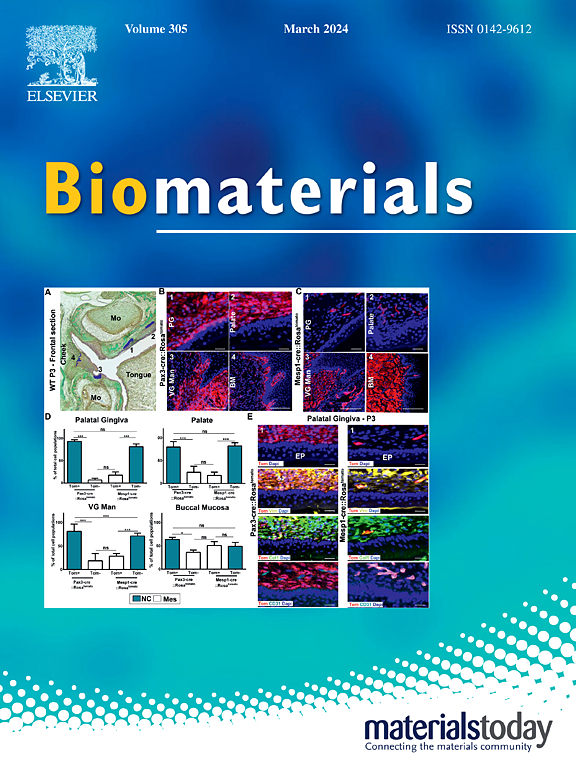Carbon-based nanozymes in cancer therapy: Current trends and future prospects
IF 12.8
1区 医学
Q1 ENGINEERING, BIOMEDICAL
引用次数: 0
Abstract
Cancer has become a major global health challenge, and current treatment modalities, including surgery, radiotherapy, chemotherapy, targeted therapy, and immunotherapy, all have inherent limitations. In recent years, nanotechnology, particularly carbon-based nanozymes, has emerged as a promising approach in cancer therapy. Carbon-based nanozymes, as a novel class of catalysts, offer excellent biocompatibility, low toxicity, and good stability. They can catalyze reactions that generate reactive oxygen species (ROS), which directly kill cancer cells or enhance the bioavailability of therapeutic agents, thereby improving treatment efficacy. Compared to conventional nanozymes, carbon-based nanozymes are easier to synthesize, more versatile, and exhibit greater durability, making them highly promising for cancer therapy. This review aims to provide a comprehensive overview of the classifications, catalytic mechanisms, and applications of carbon-based nanozymes in cancer therapy, with a focus on catalytic and multimodal treatment strategies. It highlights the unique advantages of carbon-based nanozymes and discusses the current state of research in this field. By synthesizing the available literature, this review offers valuable insights for researchers and encourages further exploration of carbon-based nanozymes in cancer treatment.
碳基纳米酶在癌症治疗中的应用:当前趋势和未来前景
癌症已成为一项重大的全球健康挑战,目前的治疗方式,包括手术、放疗、化疗、靶向治疗和免疫治疗,都有固有的局限性。近年来,纳米技术,特别是碳基纳米酶,已经成为一种很有前途的癌症治疗方法。碳基纳米酶作为一类新型催化剂,具有良好的生物相容性、低毒性和良好的稳定性。它们可以催化产生活性氧(ROS)的反应,直接杀死癌细胞或提高治疗剂的生物利用度,从而提高治疗效果。与传统的纳米酶相比,碳基纳米酶更容易合成,更通用,并且表现出更强的耐久性,这使得它们在癌症治疗方面非常有希望。本文综述了碳基纳米酶的分类、催化机制及其在癌症治疗中的应用,重点介绍了碳基纳米酶的催化和多模态治疗策略。重点介绍了碳基纳米酶的独特优势,并讨论了该领域的研究现状。通过对现有文献的综合,本综述为研究人员提供了有价值的见解,并鼓励进一步探索碳基纳米酶在癌症治疗中的应用。
本文章由计算机程序翻译,如有差异,请以英文原文为准。
求助全文
约1分钟内获得全文
求助全文
来源期刊

Biomaterials
工程技术-材料科学:生物材料
CiteScore
26.00
自引率
2.90%
发文量
565
审稿时长
46 days
期刊介绍:
Biomaterials is an international journal covering the science and clinical application of biomaterials. A biomaterial is now defined as a substance that has been engineered to take a form which, alone or as part of a complex system, is used to direct, by control of interactions with components of living systems, the course of any therapeutic or diagnostic procedure. It is the aim of the journal to provide a peer-reviewed forum for the publication of original papers and authoritative review and opinion papers dealing with the most important issues facing the use of biomaterials in clinical practice. The scope of the journal covers the wide range of physical, biological and chemical sciences that underpin the design of biomaterials and the clinical disciplines in which they are used. These sciences include polymer synthesis and characterization, drug and gene vector design, the biology of the host response, immunology and toxicology and self assembly at the nanoscale. Clinical applications include the therapies of medical technology and regenerative medicine in all clinical disciplines, and diagnostic systems that reply on innovative contrast and sensing agents. The journal is relevant to areas such as cancer diagnosis and therapy, implantable devices, drug delivery systems, gene vectors, bionanotechnology and tissue engineering.
 求助内容:
求助内容: 应助结果提醒方式:
应助结果提醒方式:


